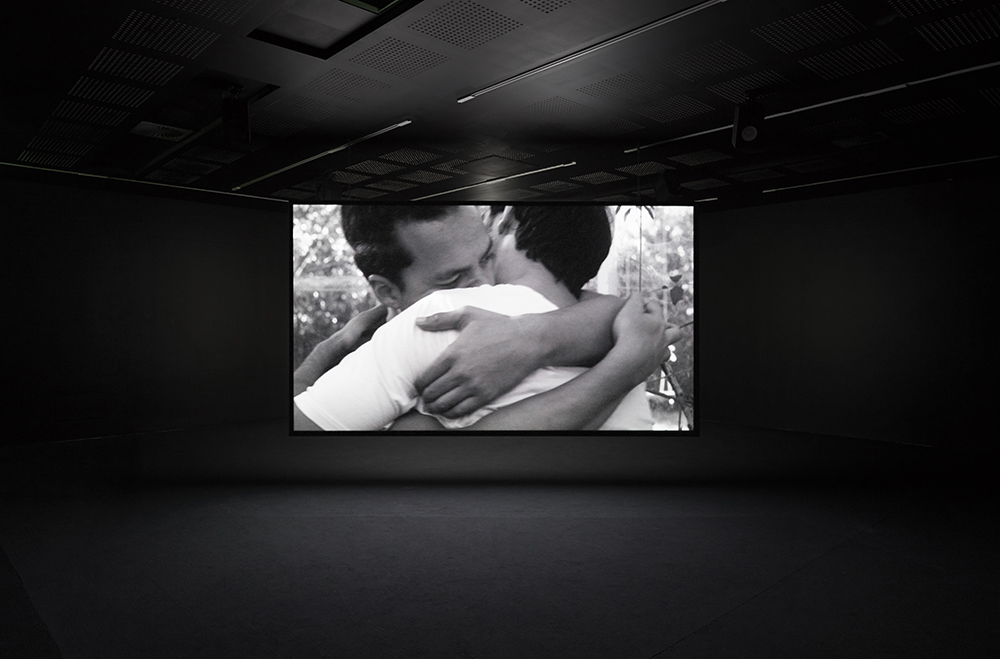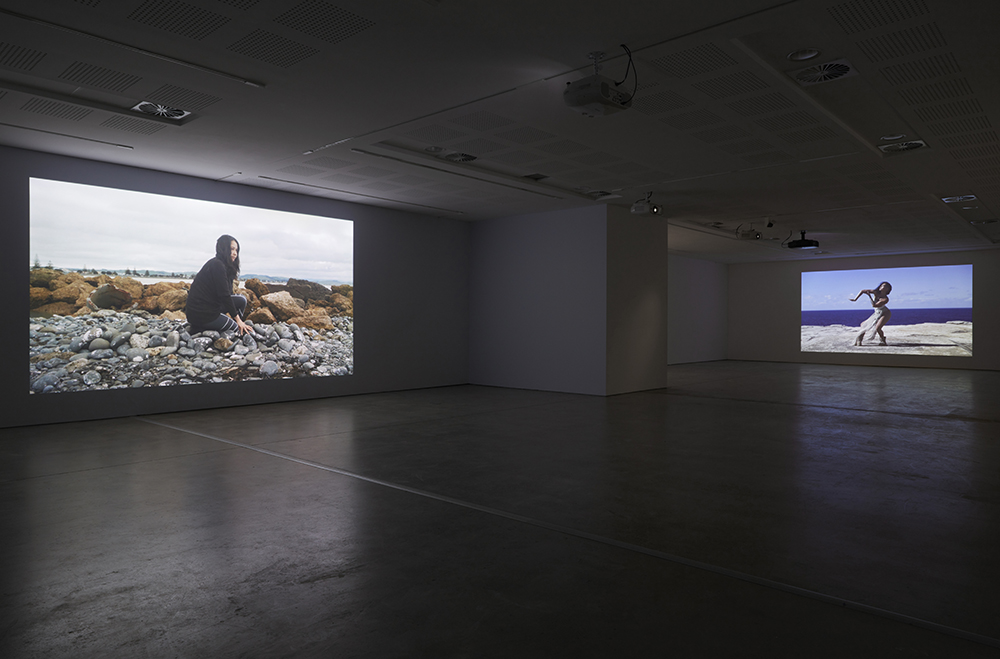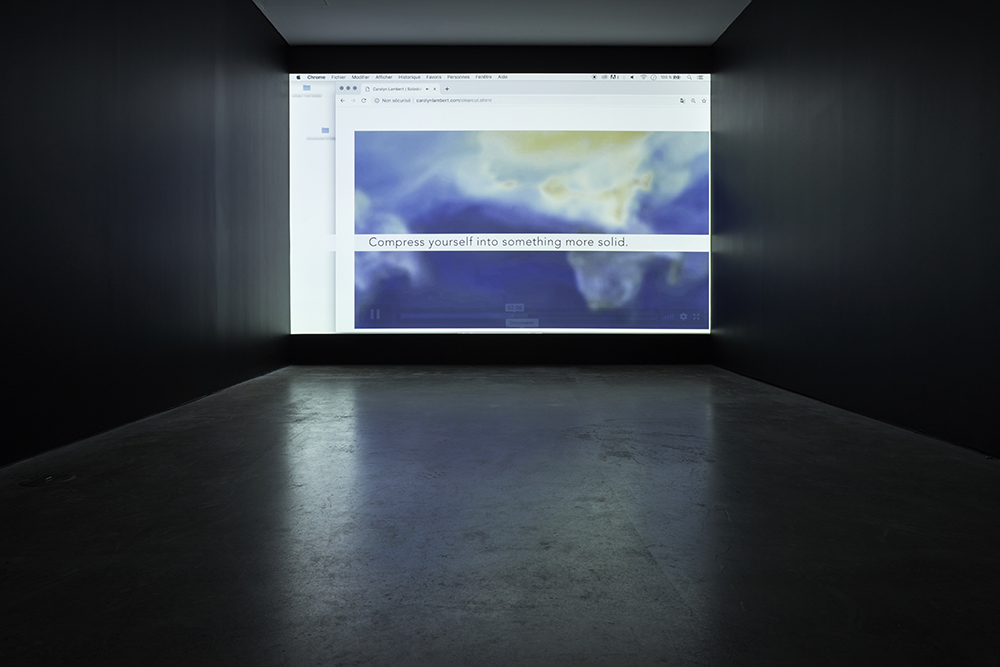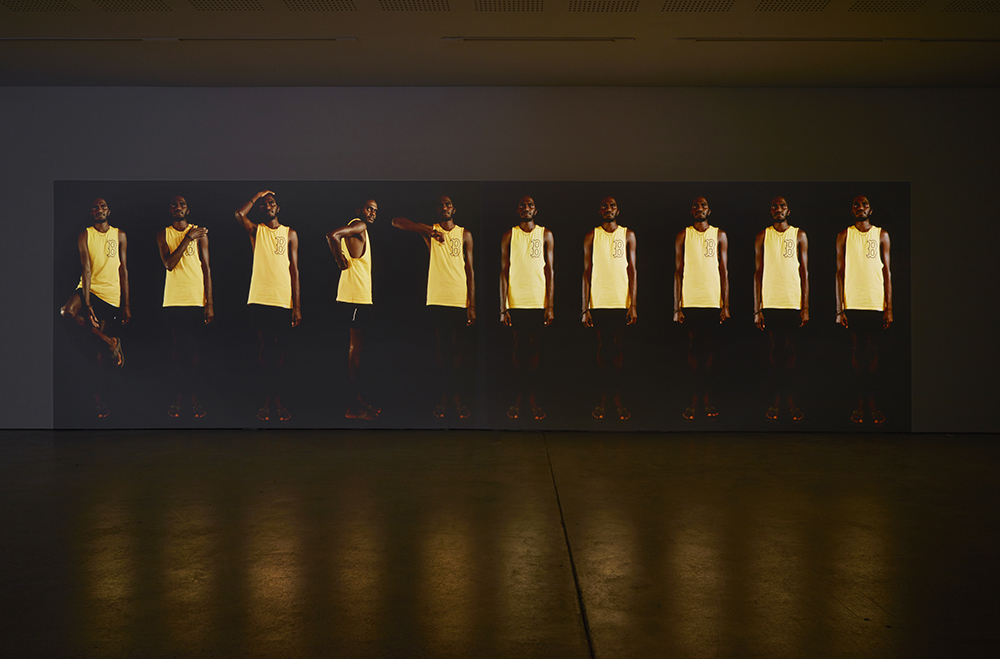ʻO le ūa na fua mai manuʻa

By James Gatt
22 April, 2020
i acknowledge and pay respects to the Gadigal of the Eora Nation, the traditional custodians of the land on which i live and work and am writing this text. i wish also to preface the text by acknowledging the influence of my western purviews, including the english language.
Translation
i attempt the exhibition title several times:
‘`O le ūa na fua mai Manu`a’
‘`O le ūa na fua mai Manu`a’
‘`O le ūa na fua mai Manu`a’
Though the english translation is not,`O le ūa na fua mai Manu`a is phonetic. Pronouncing the exhibition title is a warm-up exercise— an apt introduction to a group show where the phonological parameters of sound and gesture are essential conduits for engagement. My natural inclination when faced with a foreign word or concept is to find an english translation. But, lacking nuance, it’s immediately clear that Google Translate is useless for even the most prosaic understanding of Indigenous Pacific terminologies used throughout this exhibition. Language is misconstrued at the best of the times. Anyone who has played telephone knows all too well the inaccuracies of translation (I said ‘exhibition at UNSW Galleries’, not ‘inhibition-triggered white totalities’.) This, for me at least, is fundamental to a globalised world. There is a difference between comprehension and interpretation, the unconscious and the deliberate.
But ‘artworks’, as the late, seminal curator Okwui Enwezor said, ‘can whisper and still have power.’1 The ten video works exhibited as part of `O le ūa na fua mai Manu`a do just this, asserting the resounding persistence of the diverse, multi-sensory Indigenous communication modes used across the Pacific: from the endangered Yolnu Sign Language (YSL) of East Arnhem Land, Australia, to Mōteatea (chanted poetry) of the Māori in New Zealand. These long-established modes provide genealogical architectures through which Indigenous whispers continue to echo, despite the menace of globalisation and imperialism, historical erasure, and the diminishment of Indigenous space and voice.
Comprehending the sophisticated poetry of millennia-long cultural practices requires something far more sensitive and evolved than Google Translate. It requires something capable of reading sensibilities, something able to decipher and learn multiple intelligences from multiple sources, something whose very nature is shaped by multiplicity: a human. Quite ironic, then, that the central provocation of `O le ūa na fua mai Manu`a illustrates the enduring threat of homogeneity and its subsumption of multiplicity.

(L-R) asinnajaq, Rock Piece (Ahuriri) (2018); Amrita Hepi, A Body of Work (At The End Of The Earth) (2017)
Image credit: Zan Wimberley
What makes us human, though? This is a very basic question posed by the exhibition. The central tenet of linguistic relativity—a branch of the study of language—holds that the structure of a language influences human cognition. But, when the toolkit with which different language-speaking groups approach circumstance is so varied, exchange and relation (even in most innocuous forms) can succumb to subjugation, singularity, and loss, if for no other reason than economy.
In all language, though, there is a distinction between content and activation. Untranslated, content is conveyed through gestural or audible activation, and we are more attuned to performing cryptic content than we might assume. Think of all the songs you’ve sung not really knowing or understanding the words (i’m having flashbacks to my seven-year-old self singing catholic hymns in Latin). To be human, i think, is to transcend ostensible divisions. We perform much that we don’t—and can’t—fully understand, learning through the subtle comprehension of osmosis. Our activations of language are, in fact, crucial to our understanding of its content (i’ve only just learnt what ‘Gloria in excelsis deo’ means after many years of singing and clapping along with my similarly oblivious church-captive peers). i catch myself in `O le ūa na fua mai Manu`a reaching for immediate english translations, assured that this is my best attempt at empathy. Then it hits me: translation is at best a delay or regression, and at worst, a flattening of nuance and paradigm.
So, what’s the opposite of ‘lost in translation’? ‘Gained from repetition’? ‘Preserved through insistence’?
‘`O le ūa na fua mai Manu`a’
‘`O le ūa na fua mai Manu`a’
‘`O le ūa na fua mai Manu`a’
Vibration
Taken from a Samoan proverb that translates most literally as ‘the incoming rain from the Samoan island of Manu’a, `O le ūa na fua mai Manu`a is interpreted metaphorically as the ‘melancholic moments leading to much-needed change.’2 The dual meaning signals the primary concerns of curator Dr Léuli Eshrāghi. We are, at once, located geographically, and are asked to consider the cultural and social politics of regional specificities, as well as the philosophical implications of transition. i often think about how we imagine and construct the future, about the very idea of ‘futurability’ (a term from one of my favourite philosophers, Franco Berardi). Two recurring questions for me are: do we go to the future, or does it come to us? And, is optimism a coping mechanism for the present, or a construction tool for the future?
In Berardi’s book Futurability: The Age of Impotence and the Horizon of Possibility (2017), he introduces the notion of vibration as an alternative to propulsion. To vibrate is to move continuously or resonate. It’s a form of repetition, of insistence, of optimism. In an exhibition comprising only video works—each looping repeatedly—repetition feels political. The cyclical repetition of the ‘archipelago of Indigenous moving image works’3 might also be thought of as vibrations: recurrence and persistence necessitated by cultural preservation and, for novice participants such as myself, an opportunity to learn and actively participate (if we allow the time required of us).

Faye Mullen, AASAMISAG (2019)
Image credit: Zan Wimberley
Vibration is more than simply physical resonance, though, and also refers to intangible registers: the vibe or atmospheric resonance of a person, place or object, or an experiential knowing. Each video in `O le ūa na fua mai Manu`a represents both a unique geographical location within the Pacific, and a physical location within the exhibition space, establishing Eshrāghi’s motif of an ‘archipelago.’ Standing in the exhibition, i am left with the powerful imagery of multiple ‘islands’ vibrating, transmitting reverberations outward until they overlap—a compelling reminder of our omnipresent connections, of our shared ‘atmosphere.’
These vibrations are felt across time and space, irrespective of geopolitical impositions, as Eshrāghi identifies in the exhibition’s catalogue essay: ‘Imaginary lines have come to divide oceans, lands, skies according to Euro-American design, yet the fluid expanses beaming with loving beings known and unknown to us defy and have always defied these arbitrary rules.’4
Eshrāghi is surely speaking here of autocratic arbitrariness, to which immortal and ethereal aspects of Indigenous culture can remain immune with vibrational defiance. In the context of this exhibition, language (in its many forms) can be thought of as the necessary infrastructure for the generation of futures, gained and preserved through repetition.
Berardi offers a cogent formula for combating impotence; for realising, as the exhibition title propounds, ‘much needed change.’5 He posits three key factors: possibility, potency, and power, formulating that:
Possibility is content, potency is energy, and power is form…When facing an alternative between different possibilities, the organism enters into vibration…Potency is the energy that transforms the possibilities into actualities…power is the selection and enforcement of one possibility among many.6
Of the multiple possibilities for Indigenous futures inscribed in the exhibited video works, i have come to realise, in line with Berardi, that potency lies not in translated contents, but in vibration. The challenge is to resist the power of singular form, of western fundamentalism, of getting lost in translation.
‘`O le ūa na fua mai Manu`a’
‘`O le ūa na fua mai Manu`a’
‘`O le ūa na fua mai Manu`a’
Invitation
Too often when we think about art, we dismiss its mood, its tone, its feeling, in favour of didactic information and intellectual discourse (i’m certainly guilty of this). But `O le ūa na fua mai Manu`a is a reminder of the necessity and richness of sensual and emotional connections. Two works in particular entranced me in this way: Gutiŋarra Yunupiŋu’s ‘Garrutu’mi Mala (My Connections)’ (2019), and Shannon Te Ao’s ‘my life as tunnel’ (2018). Why i wanted to spend more time with these works, i realise, has to do with the manner of their dissemination, their tone. When encountering Yunupiŋu and Te Ao’s works they felt tender, vulnerable, and open.

Gutiŋarra Yunupiŋu, Garrutu’mi Mala (My Connections) (2019)
Image Credit: Zan Wimberley
In ‘Garrutu’mi Mala (My Connections)’, Yunupiŋu invites us to collaborate as he performs, in silent moving image, a series of signs in Yolnu Sign Language (YSL). Born hearing impaired, YSL has been formative and essential to Yunupiŋu. The video medium is, again, pivotal here. We perform with Yunupiŋu, occupying the same space-time, if only temporarily. Ten identical frames featuring Yunupiŋu, near-lifesize, are projected side-by-side on the gallery wall. In each frame, Yunupiŋu contorts his body in simple gestures of kinship: tapping his chin, head, leg or back, raising his elbow slightly. Each gesture is repeated three times before the video loops and the sequences recommence. Yunupiŋu’s demeanour and expression appear friendly and generous. There is nothing esoteric or overly aestheticised about the video. Without realising, i begin performing the gestures myself. The connection is made viable through the familiar language of the body. Though the symbolic gestures remain coded, the language of Yolnu—an aspect of Yirrkala culture (geographically located in Arnhem Land)—has pollinated. That is, the language has inhabited a new human host, where it can vibrate in concert with pre-existing knowledge. (Given the current Covid-19 pandemic, i wish to clarify here that unlike biological intruders that seek to monopolise, cultural pollen diversifies and contributes to multiplicity).
The disregard of social fabric in favour of individualism (a western ideology now manifest globally as neoliberalism) has always seemed utterly ridiculous to me. Margaret Thatcher’s famous separation of individuals and society comes to mind: ‘And, you know, there is no such thing as society. There are individual men and women and there are families.’ But the very term individual is relative. We are individuals (plural) in society. As society has expanded globally to encompass international individuals, its significance has never been greater, yet, ironically, individuals seem increasingly alienated in this expansion, unable to calibrate multiplicity and difference. It is here that Indigenous modes of kinship and relation remind us of the languages we already share, which can—and should—be embraced.
In Te Ao’s moving black and white video ‘my life as tunnel’, we witness two Māori men performing simple gestures of affection, framed by a solemn audio of ritualistic singing. The tone is undoubtedly one of melancholy and loss. Though this type of platonic affection is rare—perhaps even startling—by western standards, its language registers, and i participate with Te Ao’s poem despite being unfamiliar with the whakapapa (Māori genealogy) or moteatea (Māori song poetry). Te Ao is a master of creating memorable experience. i remember vividly the feeling i had when encountering his compelling video installation ‘two shoots that stretch far out’ (2013–14) in the 19th Biennale of Sydney. The footage depicted Te Ao reciting poetry to animals—an affirming proposition that all living beings feel and can therefore connect, that we needn’t interpret to comprehend. There is deep sensitivity and humanity to Te Ao’s work that feels indiscriminately inclusive; more about sound than content; about vibrations that are felt. When writing to Te Ao about his practice, he responds:
For our entire existence, Māori have relied on poetic imagery in various forms, most prominently oral traditions where a poetic vernacular poses perhaps the most purposeful collapse of the everyday, the existential and aspirational.
Reflecting on the assertiveness and singular authority that seems to be common practice in art making, i realise how rare and beautiful the inclusive approaches of Yunupiŋu and Te Ao are. Herein is our invitation to participate, and, if we accept, to collaborate. Eshrāghi’s overall curatorial approach feels much the same. Prompted to consider what curating is, i recall a quote by artist Michael Asher: ‘I see myself as an author of situations, not of the elements involved in them.’7 Bringing together disparate neighbouring cultures in `O le ūa na fua mai Manu`a, Eshrāghi has authored a pluralistic situation without a sanitising authorship. As the exhibition’s foundation, this encourages us to participate with content in a similarly liberal manner. To bypass the means (activation) with which we approach the end (understanding) in this exhibition, is to subject the content of Indigenous modes and their possibilities, as well as ourselves, to stubborn predeterminism.
‘`O le ūa na fua mai Manu`a’
‘`O le ūa na fua mai Manu`a’
‘`O le ūa na fua mai Manu`a’

Shannon Te Ao, my life as a tunnel (2018)
Image credit: Zan Wimberley
Activation
The provocations of `O le ūa na fua mai Manu`a pertain to broader conversations that have come to define our current social, political, economical, and environmental context. The exhibition brings to mind the prevalent distinctions and entanglements of such binaries—populism versus pluralism, globalisation versus regional specificity, and mono-culturalism versus biodiversity. In all matters of togetherness, we are tasked with the challenge of multiplicity. i’m also faced personally with many troubling questions since visiting the exhibition. Why do i know more about geographically distant cultures than i do about my Pacific neighbours? Why don’t i know a single word or phrase in Gadigal? Why is the only term from the Pacific i know ‘Kia Ora’? Like anything, we must accept personal responsibility for our shortcomings and be self-activated enough to remedy them.
As is strikingly obvious in our current climate, however, individual efforts are seldom adequate. Preserving the integrity of multiplicity requires collective pluralistic action. Such action—a fundamental attribute of group exhibitions, emphasised with particular finesse in `O le ūa na fua mai Manu`a—is required to affect real change. What’s strikingly obvious is that we have written global narratives with so little understanding of the multilingualism required.
Amidst the Covid-19 crisis, we have all been faced with new challenges. Most fundamental to the pandemic is the inextricable relationship between personal and collective interest. Finding an agreeable solution requires, as Emmanuel Macron pleaded with his French citizens recently, ‘individual and collective action.’ While we grapple so overtly with change, and consider rewrites for our current models for the future, `O le ūa na fua mai Manu`a is, for me, a shining example of how we might activate pluralism. i will leave you with the wonderful Enwezor:
A new generation of curators and museum professionals with different fields of knowledge is emerging…I hope these people will give institutions the opportunity to think about how to complicate the narrative of societies with colonial affiliations, which necessarily are mixed societies. If we have an open mind, Western art doesn’t have to be seen in opposition to art from elsewhere, but can be seen in a dialogue that helps protect the differences and decisions that present the material, circumstances and conditions of production in which artists fashion their view of what enlightenment could be.
- La Biennale di Venezia (@la_Biennale), (15/03/19), retrieved from: https://twitter.com/la_Biennale/status/1106513408902483968
- Dr Léuli Eshrāghi, `O le ūa na fua mai Manu`a, exhibition catalogue, UNSW Galleries, Sydney, p. 3
- ibid., p. 3
- Dr Léuli Eshrāghi, ‘`E Pala Ma`a, `Ae Lē Pala `Upu’ in `O le ūa na fua mai Manu`a, exhibition catalogue, UNSW Galleries, Sydney, p. 6
- Dr Léuli Eshrāghi, `O le ūa na fua mai Manu`a, exhibition catalogue, UNSW Galleries, Sydney, p. 3
- Franco Berardi, Futurability: The Age of Impotence and the Horizon of Possibility, (Verso: London, 2017), pp. 1-2
- Daniel Marzona, ‘Michael Asher’ in Conceptual Art, (Germany: Taschen, 2005), p. 32